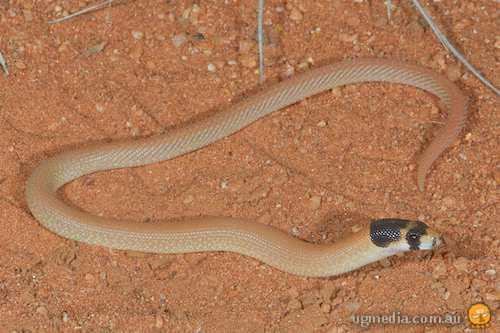Order Scaled reptiles | Class Reptilia Phylum Chordata Rank Species | |
 | ||
Similar Pygopus, Common scaly‑foot, Delma, Burton's legless lizard, Lialis | ||
Hooded scaly foot lizard feeding
The hooded scaly-foot, Pygopus nigriceps, is an endemic Australian legless lizard of the Pygopodidae family.
Contents
- Hooded scaly foot lizard feeding
- Description
- Taxonomy
- Ecology
- Diet
- Behavior and defense
- Reproduction
- Predation
- Differentiating from snakes
- References
Description

Adult hooded scaly-foots range from 45 to 55 cm long, with an average snout to vent length of 22.7 cm. Females are generally larger than males. Hooded scaly-foots show no trace of forelimbs, whilst the hind limbs are reduced to scaly flaps. These hind limbs are small and paddle-shaped, with modified scales which do not aid in movement.

The scales of the hooded scaly-foot are smooth and weakly glossed. Usually, it has 120 or more ventral scales, which are in a paired series, much larger than the adjacent body scales. Body colour varies from brown to reddish-brown, with desert specimens usually a more orangish colour and other individuals a duller brown. It is white below. The species has little to no body pattern, with oblique dark lines converging mid-dorsally.

These scaly-foots are characterised by black bands across the head and neck which may look like a hood. This hood comprises a band across the eyes onto the lips, a dark smudge on the nostrils, and a broad band across the neck. These dark bands may fade or merge with age. The lidless eye is well developed, covered with a transparent spectacle. The species is able to lick clean this spectacle using its broad, fleshy tongue. It also retains conspicuous ear openings.

The hooded scaly-foot can be differentiated from the four other species in the genus Pygopus if the nostril contacts the first upper labial scale.
Taxonomy

The closest relatives of the pygopodids are the Gekkonidae. The pygopodids and geckos share a number of characteristics; the two families may actually be one, and pygopodids may actually be limbless geckos. Shared characteristics include: the production of parchment-shelled eggs in clutch sizes of two; the ability to lick clean the clear spectacles which cover their lidless eyes; and the sharing of a voice in the form of a “harsh squeak”. The skulls and inner ears of the pygopodids are also similar to those of geckos.
Ecology

The hooded scaly-foot is found throughout Australia, except for the wetter areas of the south and Tasmania. The Pygopodidae family is endemic to Australia and New Guinea.
The species is mostly nocturnal, due to the generally hot weather where it occurs, although in cooler conditions, it forages by day. It is a terrestrial surface-dweller, but individuals have been noted up to 1.5 m above the ground in vegetation. Captive scaly-foots have lived up to seven years, but little is known about ages of individuals in the wild.
Hooded scaly-foots are found in a range of habitats, favouring dry open habits. They are found particularly in sandy deserts vegetated with triodia, but also in open woodlands and shrublands. The species shelters under rocks and woody debris, in grass tussocks and soil cracks, abandoned burrows, insect holes, and in termite mounds.
Diet
The hooded scaly-foot feeds predominantly on surface-active arthropods. Insects are the main prey type, while it is also noted to feed on spider egg sacks and scorpions. The species has been observed to actively search for prey. Once caught, larger prey is crushed and disabled as the hooded scaly-foot rotates its body rapidly, in a crocodile-roll fashion. Body fluids are then licked up.
Behavior and defense
Scaly-foots move through lateral undulations of their bodies and tails, and in open terrain they have been noted to move in wriggling leaps. The hind-limb flaps are held alongside the body during movement, although they may be extended when stressed or when climbing. As stated earlier, hooded scaly-foots have a voice. This harsh squeak is emitted under stress and occasionally in social interactions.
When disturbed, hooded scaly-foot raise their heads and fore parts of their bodies from the ground, flatten their necks, and flicker their tongues, occasionally striking out. The species does this in apparent mimicry of venomous snakes, to deter predators. The markings on the hooded scaly-foot resemble those of young brown snakes. When grasped, they struggle fiercely, rotating their bodies and uttering long squeaking sounds. They readily shed their tails and will regenerate a new one. The regenerating tail can be identified through a change in scale arrangement and pattern.
Reproduction
Hooded scaly-foots are oviparous, laying two parchment-shelled eggs per clutch. Pygopus species have been noted to lay communally, while known incubation periods range from 66 to 77 days. Pelvic spurs, modified spine-like scales, are found in addition to the hind-limb ‘flaps’ on males, are thought to assist the male in gripping the female.
Predation
Predators of the hooded scaly-foot include: raptors, elapid snakes, goannas, feral cats, and foxes. Burton’s snake lizard (Lialis burtonis) is also known to eat legless lizards. In all cases, legless lizards are a minor component of the predator’s diet.
Differentiating from snakes
Legless lizards are often killed due to their similar appearance to snakes. A number of external characteristics can be used to distinguish legless lizards (including the hooded scaly-foot) from snakes:
